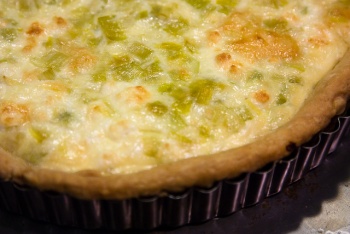I can’t make a tarte without thinking of this. (Here it is in English as well.) There’s no reason to love these little videos, but I find myself strangely drawn in by them. And yes, I can feel myself losing whatever minimal credibility I might have as I’m typing this. What was I cooking as I daydreamed of my two egg-shaped heroes and the outlandish cast of characters they interact with? Belgian Leek Tarte with Aged Goat Cheese.
As usual, I’m a complete sucker for the writing and recipes of one Molly Wizenberg (the lady behind the Orangette blog). In this month’s Bon Appetit, she tells us how to make Leek Confit (which I could have happily eaten all by itself, straight from the pot - seriously, if you don’t have the patience to make a tarte, at least give the confit a try). The leeks at the grocery store are gorgeous right now, and Texas finally appears to have caught on to the notion that bigger is not always better because the leeks I’ve purchased recently have been relatively thin and blissfully tender.
Once the confit is finished, it is used in the tarte (they spelled it “tart”). After the crust is prepared and baked and baked some more, leek confit is layered with goat cheese and then more leek confit before being filled with a binder of cream, milk, and eggs. (By the way, this method of layering the dry ingredients and then pouring the wet around them helps to avoid the unpleasant overflow situation I ran into the last time I made a tarte.)
After the tarte was baked and allowed to cool a bit, we dug in. It was incredible. The leeks, already meltingly rich and flavorful were exquisite with the creamy goat cheese and unobtrusive egg. The relative mildness of the filling allowed the buttery crust to figure prominently in our enjoyment. And even better - it reheated pretty darned well (on a sheet pan, in the oven).

Seriously, I know this is the second time I’m writing this in a single post, but if you love leeks, definitely make the leek confit. It would be delicious just spread on some buttered toast.
Another note on leeks - especially if you’ve never dealt with them before - they can be sort of difficult to clean. Because of their structure and the way they grow, leeks are often really dirty and gritty, and you wouldn’t want that messing up your wonderful food! Here’s my approach. I cut the tough dark green part off (the part I’m not going to eat anyway). Then I split the remainder down the middle lengthwise, taking care not to slice through the root end. Next, with the root end facing down, I run water lightly all through the newly split leek, working the dirt out with my fingers as necessary. Once you feel comfortable that they’re clean, turn them upside down (root end up) and gently smoosh the water out of the leek (it should hold together fairly well if you’ve left the root end intact). From there you can slice off the root and braise them or chop them up and use them as you see fit.